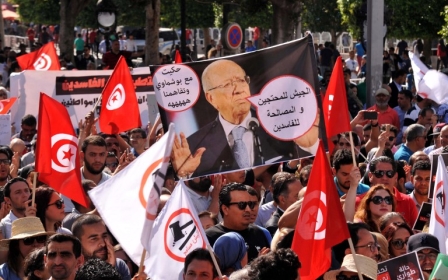Thousands of Moroccans rally against corruption
Thousands of Moroccans marched in a northern town to protest against injustice and corruption on Thursday, seven months after fishmonger Mouhcine Fikri was crushed inside a garbage truck there while trying to retrieve fish confiscated by the police.
Waving banners proclaiming "Are you a government or a gang?" and local protest flags, the march made its way peacefully through the centre of al-Hoceima, packing the main square under the watch of police and gendarmerie checkpoints.
'Our demands are clear, we want the removal of the security presence here, we want hospitals.... we want jobs, we want universities'
-Mohammed Boumasoud, protester
Political protests are rare in Morocco, but tensions in al-Hoceima have been simmering since October following the death of fishmonger Mouhcine Fikri.
The incident sparked outrage against hogra, a colloquial Derja Arabic term for deprivation of dignity because of official abuses or corruption, and prompted some of the largest protests since Arab Spring-inspired demonstrations in 2011.
Thursday's marchers filled the main square and local businesses shut shops, cafes and restaurants in an unprecedented show of support. Crowds booed as they passed a police station.
"Our demands are clear, we want the removal of the security presence here, we want hospitals.... we want jobs, we want universities," said 23-year old Mohammed Boumasoud, a member of the Hirak movement that denounces corruption.
Two police and three gendarmerie checkpoints filtered traffic entering the city - an increase from the usual level of security.
Moroccan authorities usually police protests heavily, nervous about unrest since the 2011 demonstrations. During those protests, Morocco's king devolved some of his authority to an elected government in a constitutional reform.
Governments in North Africa are wary of protests tapping into frustrations among unemployed youth over jobs and a lack of development in marginalised areas. Tunisia this month saw protests that threatened to block gas production in the south of the country.
As crowds gathered in one square, Nasser Zefzafi, leader of Hirak rallied protesters over a megaphone. He has been the target of attacks in pro-palace media outlets, who have accused him of being a separatist for the Rif region.
The anger over Fikri's death, which shocked even staunch supporters of the palace, was a reminder of the broader resentment at the establishment over joblessness and the gap between rich and poor that partly drove the 2011 pro-democracy protests.
Earlier this week, the Moroccan government released a statement acknowledging the protests in the Rif and urging officials to move quickly to implement a development strategy aimed at providing jobs.
Rif briefly declared independence in the 1920s during the resistance against Spanish colonial rule. Even after independence the region had a contentious relationship with central authorities, often claiming it has been abandoned.
"Mouhcine Fikri's death was the last drop that made the glass overflow," said activist Rabih Boushaaoul, a member of Hirak. "Fikri's death woke the Rif up from a deep sleep."
Middle East Eye propose une couverture et une analyse indépendantes et incomparables du Moyen-Orient, de l’Afrique du Nord et d’autres régions du monde. Pour en savoir plus sur la reprise de ce contenu et les frais qui s’appliquent, veuillez remplir ce formulaire [en anglais]. Pour en savoir plus sur MEE, cliquez ici [en anglais].




